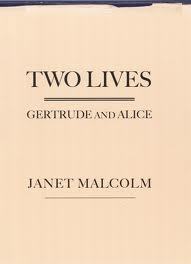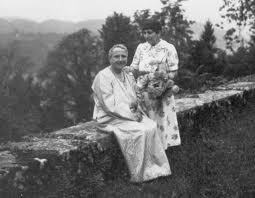 [Origin: St. Mark’s Bookshop remaindered pile, originally $25, purchased for $7. 2007, 224 pages, non-fiction]
[Origin: St. Mark’s Bookshop remaindered pile, originally $25, purchased for $7. 2007, 224 pages, non-fiction]
I just finished this book, and I can’t say that I’m sure what the author’s intention was. It’s a book about writing a book about Gertrude Stein. It’s also written in an engaging, sometimes acerbic, direct and personal style that makes it a pleasure to read. Her approach to biography is refreshing: she refuses to give a definitive narrative take on another person’s life; she highlights the outstanding biographical questions; she outlines the process by which she came to certain conclusions.
* No chapters, which gives it the flow of a long magazine article. It’s structured in three long sections. Part I is about Stein & Toklas during World War II, how they managed to survive; Part II is an inquiry into the impenetrable The Making of the Americans, including a great account of Malcolm’s reading of it and the scholarship surrounding the juicy notebooks Stein kept while writing it; Part III mostly concerns the fate of Alice Toklas after the death of Stein… All of this is interspersed with Malcolm’s questions about what can constitute established fact when dealing with biography; her dealings with various Stein critics & her own investigations into the life of Stein & Toklas; her own take on Stein’s writing.
* Perhaps an inadvertent theme that comes through is Malcolm’s distress at Stein & Toklas’s denial of  their Jewishness, in both their life & their writing. (They were close friends with a Nazi collaborator, who was the one who helped them remain in occupied France, did not ever write directly about the atrocities of the Holocaust, although there was no way they could not have known, at a certain point.)
their Jewishness, in both their life & their writing. (They were close friends with a Nazi collaborator, who was the one who helped them remain in occupied France, did not ever write directly about the atrocities of the Holocaust, although there was no way they could not have known, at a certain point.)
* Surprises revealed: Stein was extraordinarily charming. She made people want to help her & be around her. She needed constant human company (visits to friends) to keep writing. Men and women both were attracted to her. She was described by more than one person as a golden presence, like the sun, or else earthy brown. However, in her youth, she was depressed, confused, hyper-critical of those around her. Her first four years in Paris were not spent hosting the great Modernist artists, but in an “American ghetto” of friends and relatives, and she spent that time depressed.
And in one of the scant end notes, on their sex life: Stein preferred “cuddles”, while Toklas got the orgasms, which Stein referred to as “cows” (whoa!). “She calls herself ‘the best cow-giver in the world.’"
* Features sweet photos of Gertrude & Alice.
* It ends abruptly. A curious ending focused on how no one actually liked poor Alice Toklas. I guess this is on par with Malcolm’s determination not to make sweeping statements or grand conclusions. But the abrupt ending makes you wonder what you’re supposed to be taking away from this bok.
* A remarkable number of "side characters” in the Stein story wrote their own memoirs and autobiographies, funny.
* Aside: How did everyone have so much time to write letters all of the time?
